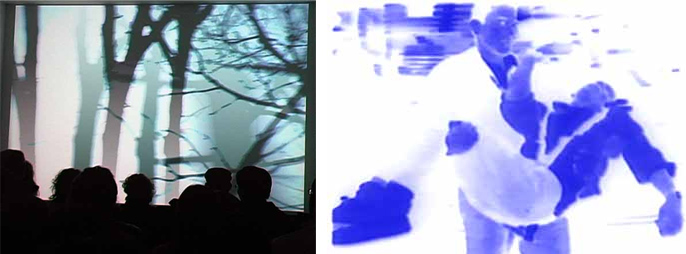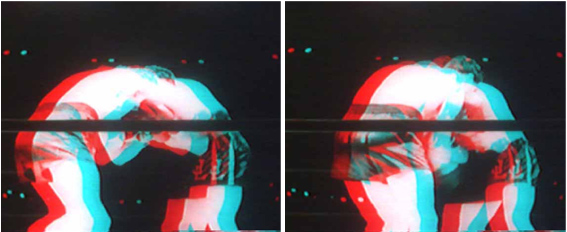|
|
 |
 |
 |
|
 |
 |
 |
 |

|
 |
 |
 |
Suara Welitoff
Nicola Trezzi

|
| Suara
Welitoff is the master of blurring. Her photographs, videos and video
installations are like ‘mechanical watercolors,’ an escape from daily
life where everything is set, clear and managed, to a new world where
everything seems to be dominated by low-definition and every moment is
out of focus. Recalling her background as a musician, the artist is able
to construct atmospheres through a well-defined chromatic palette,
which has already become her trademark. | | |  | Suara Welitoff and Thalia Zedek, A Million Sunsets, 2005. Live music and video performance, installation view at Participant Inc for Performa 05, New York. Courtesy the artists. Suara Welitoff, Untitled (Blue), 2007. Video still, courtesy the artist and Allston Skirt Gallery, Boston | | | | | Nicola Trezzi: How many years have you been living in your studio/home?
Suara Welitoff: 10 years.
NT: Where were you born?
SW: I was born in Jersey City. I grew up there and stayed until the age of 18. Later, I traveled to different places and I lived in San Diego, California and Maine. In San Diego I played music with people and was in a band. I didn’t really like living in California that much so I came back to the East Coast. In California, it’s a total driving culture. Everyone drives constantly, and I prefer it here where you can walk everywhere. NT: Could you tell me about this picture?
SW: This is a video still from a show I had in 2005 at the Allston Skirt Gallery called "A Million Sunsets." NT:
And you are about to present a new show at Allston Skirt Gallery. Can
you tell me about this show, and why you decided to call it "Anonymous"?
SW: I call it “Anonymous” because I think of the many, many people within the long procession of history. NT: Do you do everything yourself for the videos, like the music, etc? SW:
Yes, I do. I operate the camera and I’m the director. Many of my videos
are silent, and the ones with sound are pretty low tech. For one, I
played a record on an old record player and just placed my video camera
in the middle of the room to record the sound. I have friends who help
me and who are also in my videos, and who I talk to about the work. Nick
Buni in particular, who is my voice of reason, and he’s in several of
the videos. | | |  | Suara Welitoff, A Million Sunsets, 2005. Video still, courtesy the artist and Allston Skirt Gallery, Boston. Suara Welitoff, A Million Sunsets 2, 2005. Video still, courtesy the artist and Allston Skirt Gallery, Boston.
| | | | | NT: Tell me about the collaboration with Thalia Zedek. How was that?
SW:
We worked together in a restaurant in 1985. We became friends and
collaborated right from the beginning. We also used to play music
together over the years. Thalia made a record cover from a photograph I
took of her. We’ve been good friends, and it seems our friendship has been much of the collaboration.
I made a video called The End is the Beginning,
in which she was the main subject. After that she invited me to
show videos behind her band. The first time we did this was at the
Market Theater in Cambridge, and then at the Museum of Fine Arts in
Boston and later for Performa05 at Participant Inc. in NYC.
NT:
You are working on an upcoming project room at P.S.1, right? If I
remember well, P.S.1 curatorial advisor and Participant Inc. director
Lia Gangitano will organize this show, and she also hosted your
collaboration with Zedek on the occasion of Performa05. How did you meet
her?
SW:
I made photographs and brought slides to a couple of galleries in
Boston, and left one at the ICA where Lia was associate curator. None of
the galleries responded, but a week later I got a call from Lia, who
was putting a show together and invited me to be part of it. We wound up
becoming close friends, and it’s funny because almost nothing ever
happens with unsolicited slides, but I didn’t know that then. Lia
started Participant Inc., a non-profit gallery in the lower east side of
NYC, and that’s where Thalia and I did our collaboration for
Performa05. Right now Lia and I are working on a project that will
hopefully be at P.S.1 in Queens sometime this year.
NT: Do you pay any attention to the type of screen? What kind of television, etc?
SW: Yes I do. You have to. But sometimes for certain places you will not have options to choose from.
NT: Have ever experimented with vintage equipment? Televisions or cameras…
SW:
No, I’ve never done that. But it sounds interesting actually. I grew up
with an old fashion TV. In fact one of my first shows was on an old TV.
It was the only thing they had there. | | | | NT: Tell me about your little collection of cameras, it seems you are preparing for an installation.
SW:
I have a small collection of different cameras I’ve used or that were
given to me. I only keep a few because I don’t have much room and I like
things to be open and not too cluttered.
NT: Tell me about your time as a musician.
SW: I played the guitar and saxophone. I played in a band in California and again back in Boston. We would get together at somebody's house or at a studio, and just play. I love playing music but don’t do it as much now.
NT: Tell me about these images. [An amazing red and blue diptych on top of the bed]
SW: I shot this film while I was in London. It’s called Blue/Red and is exhibited on two monitors next to each other. The poster was made for a show I had, called “Then Something Happens.”
NT: What camera do you use?
SW:
I started out with film cameras but I never edited, or spliced the
film. I always transferred and edited in video. You can’t get film
anymore for some of these old cameras. Now I use a video camera that’s
small enough to carry with me.
NT: So who inspires you?
SW:
I love a lot of painters. Right now I’ve been looking at Wilhelm
Sasnal, Peter Doig, but really too many to mention and I am interested
in the work of so many artists. NT: Indeed, the way you make your pictures is very close to painting and in particular watercolor, like Untitled (Blue). You have a very well defined palette, don't you?
SW:
I guess so. It’s more like a style or something that develops like
handwriting. You just have your own. I approach making videos as if I
was a painter. I don’t really tell a story, it’s more to do with
questions I’m asking.
NT: Another confirmation of this closeness is when you received the Maud Morgan Prize [awarded by the Museum of Fine Arts in Boston to a Massachusetts woman artist in mid-career], which is often reserved for painters… they decided to choose your 'painterly films'…
SW: Yes. That was great, my first exhibition at an American Museum.
NT: How did everything start with video?
SW:
I began with photography using long exposures. 2 to 3 minutes. Then I
started films. I‘ve been making videos for about 10 years, and during
this time it’s become much easier to show and present my work. It keeps me busy. | | | |
 |
 |
 |
|
|
|
|
 |

|
 |
 |
 |
 |
 |
 |
 |
 |
 |
 |
 |
| Giancarlo Politi Editore - via Carlo Farini, 68 - 20159 Milano - P.IVA 09429200158 - Tel. 02.6887341 - Fax 02.66801290 - info@flashartonline.com - Credits
|
|
 |
|